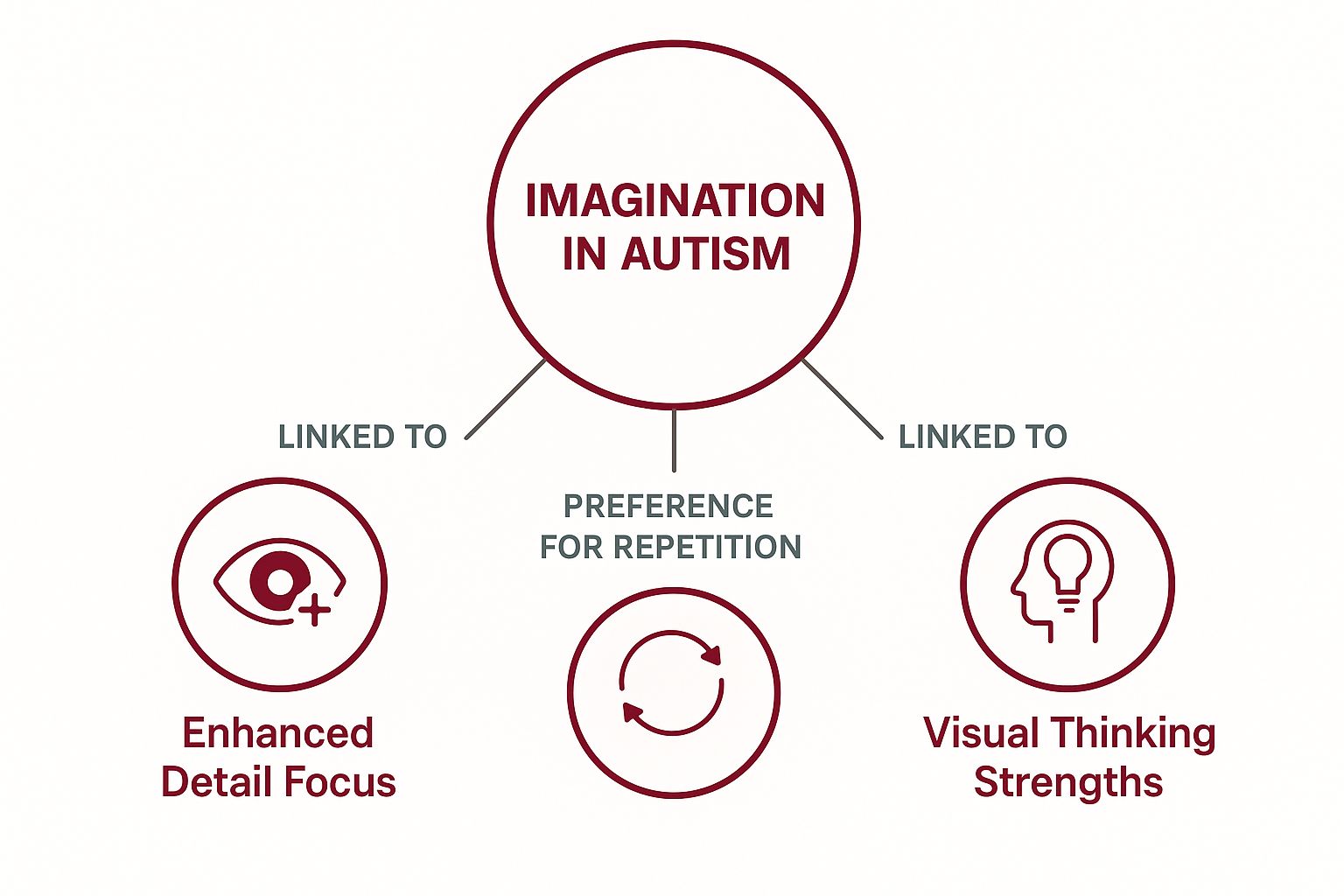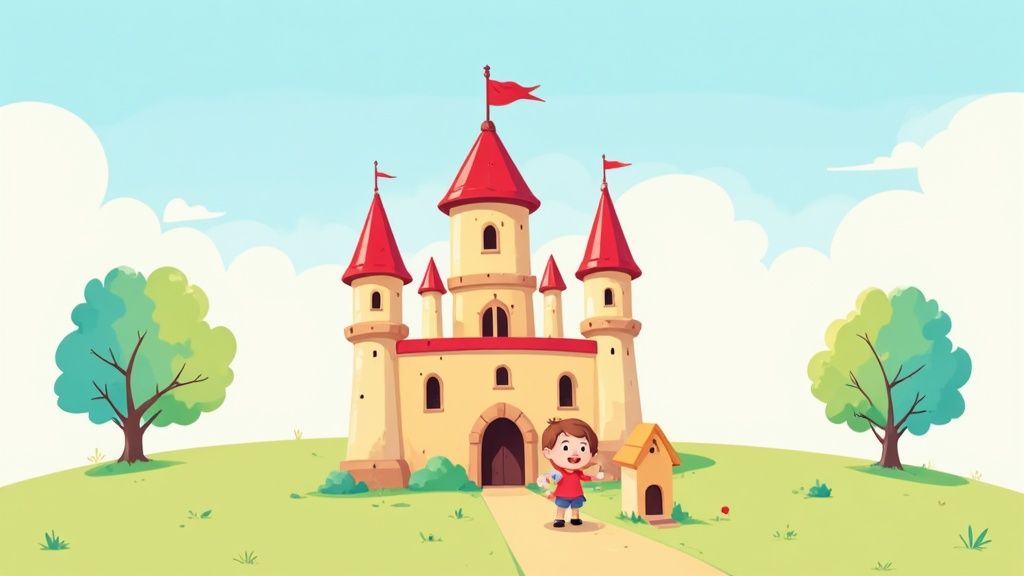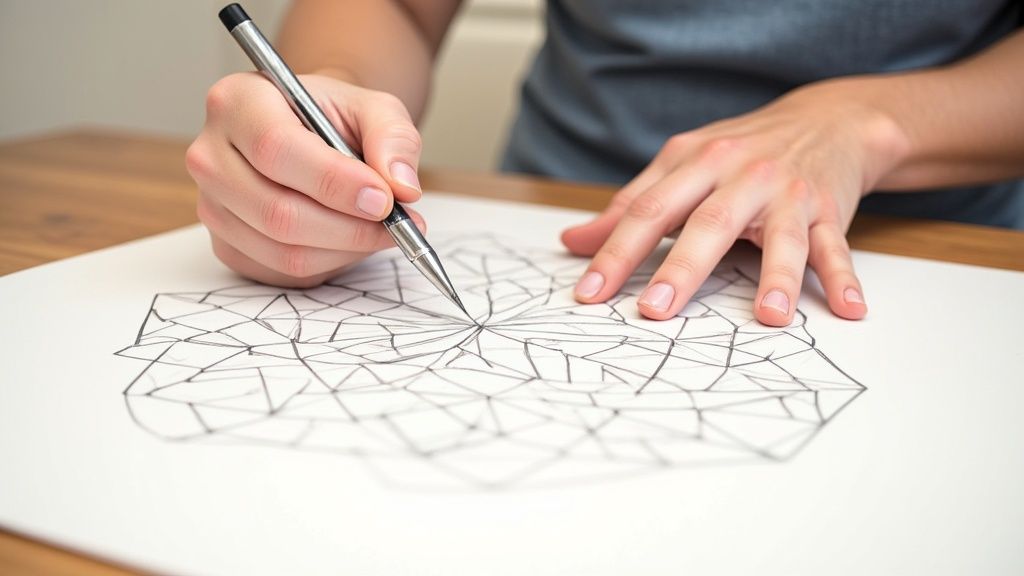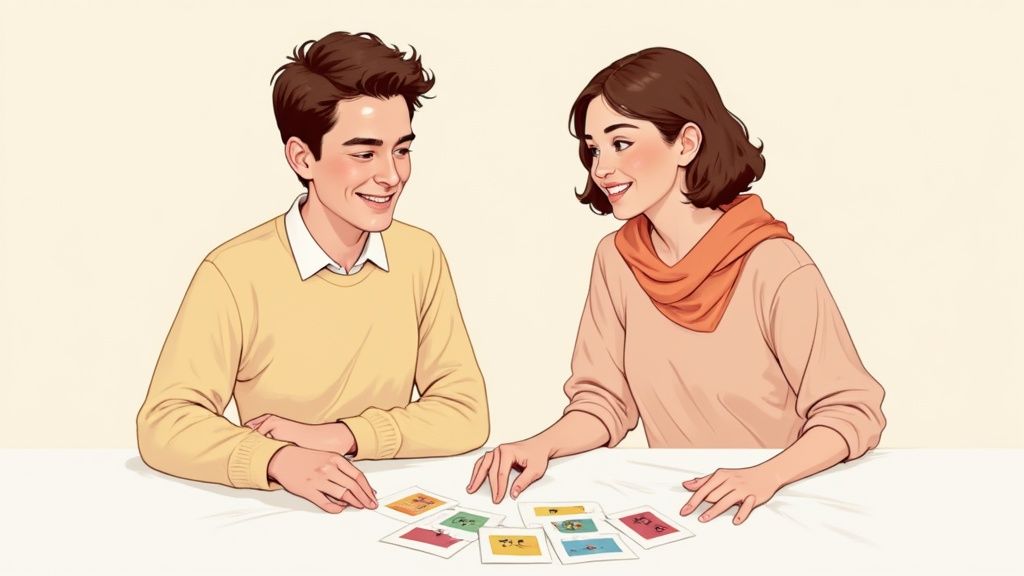The link between autism and imagination is tangled in misunderstanding. It's often viewed as a deficit, a missing piece, rather than simply a different way of being. But the truth is, autistic individuals have incredibly rich inner worlds; their imagination just operates on a different frequency. It often prioritizes detail, logic, and systems over the kind of spontaneous social improvisation we’re taught to expect.
Rethinking Imagination in Autistic Individuals
For decades, the dominant story was that autistic people lacked imagination. This idea took root from observations of childhood pretend play, which is a common developmental signpost. But this view is like judging a fish on its ability to climb a tree—it completely misses the point. Imagination isn't one single skill; it’s a whole spectrum of different abilities.
Instead of a lack of imagination, autistic individuals often show a different type of imaginative thinking. Their creativity might not bubble up in impromptu social games, but it flourishes in the construction of breathtakingly detailed worlds, complex systems, and intricate narratives.
Think of it as the difference between an improv comedian and a world-building novelist. Both are deeply creative, but their process and what they produce look very different.
A Different Operating System
The autistic brain tends to process information with a unique kind of intensity and focus. This can lead to a natural preference for logic, patterns, and structure, which in turn shapes how imagination is expressed.
Imagination in autism is not an absence but a different presence. It's the architect building a city brick by brick, not the actor improvising on an empty stage. This detail-oriented approach is a strength, not a weakness.
This infographic helps visualize some of the core tendencies that influence the autistic imaginative experience.
As the visual shows, a focus on details, repetition, and visual thinking aren't barriers to imagination. They are the very foundation of a unique and powerful creative process. This cognitive style is often tied to monotropism—an intense, deep focus on a handful of interests. To dig deeper into this concept, you can learn more about how monotropism and autism are connected in our detailed guide.
The following table offers a quick comparison, showing how imaginative expressions can vary and challenging the one-size-fits-all view of creativity.
How Imagination Can Manifest Differently
| Imaginative Domain | Common Neurotypical Expression | Common Autistic Expression |
|---|---|---|
| Storytelling | Spontaneous, character-driven narratives, often focused on social dynamics and emotional arcs. | Detailed world-building, intricate plotlines with logical consistency, often focused on systems, rules, or special interests. |
| Pretend Play | Social role-playing (e.g., "house," "doctor") with flexible, improvised rules. | Re-enacting scenes from movies or books with high fidelity; arranging objects in systematic or narrative patterns. |
| Problem-Solving | Brainstorming multiple, varied ideas; flexible, "outside-the-box" thinking. | Systematic, logical exploration of possibilities; identifying patterns to find novel, efficient solutions. |
| Artistic Creation | Expressive, abstract art; focus on emotion and overall impression. | Highly detailed, realistic, or pattern-based art; creation of complex systems, maps, or technical designs. |
This table isn't meant to be a rigid set of rules, but rather a guide to understanding the different flavors of imagination. It highlights that creativity isn't a single path but a landscape with many trails.
So, instead of asking if autistic individuals have imagination, a much better question is how their imagination shows up. When we start recognizing these differences, we can begin to see the incredible strengths and unique creative gifts that come from the autistic experience. This shift in perspective is the first step toward better support and genuine appreciation.
Why Imaginative Play Can Be Different in Autism
For a lot of neurotypical kids, imaginative play is like a bustling social laboratory. It's where they try on different hats—doctor, chef, explorer—to test out social roles and figure out the unwritten rules of getting along with others. This kind of spontaneous, social pretend play often looks different in autistic children. It’s not that they lack imagination, but their path to understanding the social world is wired differently from the ground up.
The real sticking point often comes down to the sheer unpredictability of social improvisation. Think about it: social pretend play is a whirlwind of subtle cues, unspoken agreements, and rules that change on a dime. For a mind that finds comfort in logic and predictability, that can be completely overwhelming. Classic stories, like the imaginative journey in "Where the Wild Things Are", show us just how rich and fluid these inner worlds can be, giving us a common reference point for these deeply personal expressions of imagination.
A Different Social Blueprint
Instead of learning by jumping into social simulations, many autistic children build their understanding of the world through other powerful methods. They often rely on meticulous observation, logic, and spotting patterns to decode social situations that others might grasp intuitively.
It's a bit like learning a new language. One person might dive right into conversations and absorb the language through immersion, while another prefers to study the grammar rules and vocabulary lists first. Both can become fluent, but their learning process is totally different. This distinction is key to unpacking the autism and imagination connection.
For an autistic child, the social world can feel like a game where everyone else seems to know the rules, but nobody shared the instruction manual. Their approach to figuring it out is often far more analytical and deliberate.
Difficulties with shared imaginative play have long been a recognized part of the autistic experience. In fact, some of the earliest research on autism identified impairments in imagination as a core feature, and today's diagnostic criteria from the American Psychiatric Association still acknowledge challenges in this area.
Sensory Experiences and Play
Another huge piece of the puzzle is sensory input. The scratchy texture of a costume, the chaotic noise of a pretend battle, or the visual overload of toys scattered everywhere can be intensely overstimulating for an autistic child. Engaging becomes almost impossible when your senses are screaming at you.
You can get a deeper feel for this by checking out our guide on understanding sensory sensitivities in adults with autism; many of these experiences have their roots in childhood.
What might look like a simple lack of interest in play could actually be a protective measure against sensory overload. Seeing it this way allows for a much more compassionate understanding. The focus shifts from a perceived "deficit" to a different neurological reality. This isn't about a missing skill—it's about a distinct developmental journey for making sense of a very complex world.
Exploring the Rich Inner Worlds of Autistic Minds
While early childhood play gives us one window into the mind, the imagination of autistic teens and adults often blossoms into something far more intricate and structured. As the pressures of social life change, their focus can turn inward, creating rich, detailed landscapes that are both deeply personal and logically sound. These aren't just fleeting daydreams—they're entire universes built with incredible precision.
This kind of internal world-building is a powerful expression of the link between autism and imagination. It taps directly into the autistic brain's knack for deep focus and systemizing—that inherent drive to understand and build systems based on rules. If a neurotypical imagination is like an improv actor, creating dialogue and action on the fly, the autistic imagination is often more like an architect, meticulously designing a city down to the very last brick.
Every single element has to make sense within the established framework, from the laws of physics in a fantasy world to the detailed backstory of one character. This creates worlds that aren't just creative, but also incredibly coherent and stable.
The Power of Immersive Daydreaming
What might look to an outsider like "zoning out" is often an active, immersive journey into these complex inner worlds. This experience, sometimes called immersive daydreaming, isn't a sign of a wandering mind. It's proof of a powerful, story-driven imagination hard at work. It’s a mental space where autistic individuals can explore ideas, process emotions, and dive into their interests without the unpredictable messiness of real-world social interactions.
A surprising number of autistic adults experience this profound level of imaginative immersion. In fact, one study showed that about 42% of adults on the spectrum engage in these vivid, structured fantasy experiences, which might reflect a greater reliance on narrative and systematic thinking. You can read more about these findings on daydreaming in autism on pmc.ncbi.nlm.nih.gov.
This intense form of daydreaming serves a few key purposes:
- A Safe Haven: It offers an escape from a world that can feel sensorially overwhelming and socially confusing.
- A Creative Outlet: It’s a space for unrestricted exploration of special interests, whether that means developing new alien species or engineering fictional technologies.
- An Emotional Sandbox: It provides a controlled environment to work through complex feelings and even rehearse for potential social scenarios.
From Inner Worlds to Outer Creations
These vibrant inner worlds frequently fuel incredible outer creations. The same mental blueprint used to construct a fantasy kingdom can be applied to all sorts of other pursuits.
The meticulously crafted inner world of an autistic person is not just an escape; it is a workshop. It’s where they forge the logic, patterns, and systems that can later become groundbreaking art, innovative code, or scientific discovery.
Think about it: an individual who spends hours designing a fictional transit system for a made-up city is honing real-world skills in logistics, planning, and systems thinking. Someone who writes thousands of words on the political history of an imaginary civilization is practicing narrative construction and causal reasoning.
These inner worlds are not a deficit. They are a different, and powerful, form of imaginative expression. They showcase a mind that doesn't just imagine things but builds them, creating robust, detailed, and logically sound realities that stand as a testament to the unique creative strengths found in autism.
Uncovering the Creative Strengths of Autism
While the old narratives often zeroed in on imaginative challenges, the reality is far more interesting. The very ways of thinking that define autism are often directly linked to incredible creative talents.
What might look like a deficit from the outside—like intense interests, a knack for spotting patterns, or strong visual-spatial skills—are actually powerful assets. They fuel a unique and valuable form of creativity that’s methodical, precise, and deeply logical.
This systematic approach to imagination isn't a limitation; it's a massive advantage in any field where detail and consistency are king.
Where Autistic Creativity Thrives
It's no surprise that many autistic individuals flourish in environments that reward deep, sustained focus. Their ability to see the world as a series of systems and patterns gives them an edge that’s hard to replicate.
This often translates into standout achievements in specific areas:
- Visual Arts: Think of art with astonishing detail and technical skill, from photorealistic drawings to intricate geometric designs.
- Music and Sound: A heightened perception of patterns can lead to a profound grasp of music theory, composition, or sound engineering.
- Engineering and Programming: The core of coding and engineering is the ability to build and take apart complex, rule-based systems—something autistic minds are often naturally wired for.
- Systematic World-Building: Whether it's in writing, game design, or a personal passion project, the talent for creating coherent, meticulously detailed worlds is a classic hallmark of autistic imagination.
These aren't just hobbies. These are highly sought-after skills that drive real innovation. The connection between autism and imagination becomes undeniable when you see how these innate abilities come to life.
Rethinking How We Measure Creativity
Interestingly, some autistic people might not describe themselves as "creative," even while they’re demonstrating remarkable skills. This disconnect often comes down to how we define and measure creativity in the first place.
While they might find spontaneous, open-ended brainstorming a bit of a struggle, they can absolutely ace objective tests that measure specific creative abilities.
The autistic imagination often shines brightest when it has a framework to build upon or a problem to solve. It’s less about pulling ideas from thin air and more about brilliantly reconfiguring the pieces already in front of them.
Research backs this up. Studies have found that while self-reported creativity might be lower among some autistic individuals, their cognitive creativity—the actual mechanics of imaginative thinking—can be positively linked to autistic traits.
For example, autistic youth often show enhanced visual-spatial creative abilities, especially when using structured tools like 3D modeling software. It's a very different skill than, say, verbal improvisation. You can dig into the full study on these mixed creativity patterns at diva-portal.org.
What this all shows is that creativity isn't one single thing. It’s a diverse set of skills. By broadening our definition, we can start to truly recognize and celebrate the powerful forms of imagination that thrive within the autistic experience.
How to Nurture Autistic Imagination
When we talk about the relationship between autism and imagination, the goal isn't to force creativity into a neurotypical box. Instead, it's about providing the right tools and environment for an autistic person's unique imaginative style to really flourish. It’s about valuing every single creative expression, whether it’s a beautifully structured piece of code or an incredibly detailed fantasy map.
The best place to start is by leaning into their special interests. These aren't just hobbies or distractions; they are powerful gateways to imaginative exploration. A deep love for dinosaurs can easily become a project to invent and illustrate an entirely new prehistoric ecosystem. An obsession with video games can evolve into designing new levels, characters, or game mechanics.
Build on Their Passions
Using a special interest as a foundation completely removes the pressure of starting from a blank slate. It provides a familiar and comfortable framework where creativity can feel both structured and purposeful.
Here are a few ways to channel these interests:
- Encourage World-Building: Prompt them to expand on what they already love. If trains are their thing, ask them to design a futuristic transit system, complete with detailed maps and schedules.
- Facilitate Storytelling: Use their passion as a launchpad for new narratives. Instead of asking for a story out of thin air, you could ask what would happen if their favorite TV characters suddenly visited a different universe.
- Provide Structured Tools: Many autistic individuals thrive when they have tools that offer a clear system. Things like LEGOs, 3D modeling software, music composition apps, or coding platforms provide a set of rules and structure that can make the creative process feel manageable and deeply rewarding.
Create a Supportive Environment
The physical and emotional space for creativity is just as important as the tools you provide. For imaginative thought to take root, the environment has to feel safe, predictable, and completely free from judgment. This often means being incredibly mindful of sensory needs.
A supportive space is one that honors the autistic person’s process. It’s a judgment-free zone where repetitive actions are understood as part of thinking and deep focus is respected, not interrupted.
Creating a sensory-friendly creative corner can make a huge difference. You can find some great tips in our guide to designing sensory room ideas for home, which can easily be adapted for any space. Simply reducing overwhelming lights, sounds, or textures allows the mind to settle in and focus on building and creating.
Ultimately, nurturing autistic imagination means being a facilitator, not a director. It's about offering open-ended materials like clay, building blocks, and art supplies, and then stepping back to see what amazing things happen. Learning about interactive story writing techniques can also offer some excellent insights into crafting engaging experiences that foster this kind of creative exploration.
When we honor their unique approach, we help them build confidence and see their own minds as the powerful, creative engines they truly are.
Embracing a Broader Definition of Imagination
For far too long, the conversation around autism and imagination has been stuck on a false premise. It's not a story about a deficit, but one of profound difference. Imagination isn't a single, narrow skill you can measure just by watching a child's pretend play. It’s a huge spectrum of creative thought, and autistic minds often navigate it in uniquely powerful ways.
Their creativity frequently blossoms from logic, detail, and systems. This can lead to the creation of incredibly intricate worlds and innovative solutions that move society forward. The autistic community is full of creative strengths that dismantle outdated stereotypes and force us to expand our whole understanding of what it means to be imaginative.
When we look past our assumptions, we start to appreciate the diverse and incredible ways autistic individuals see and shape the world. This is the heart of neurodiversity—recognizing that a different way of thinking isn't less, but a vital part of human creativity.
If there's one thing to take away, it's a call for a much deeper understanding. When we embrace a broader definition of imagination, we move beyond simplistic labels. We can finally start to celebrate the complex, detail-oriented, and systematic creativity that is so often a hallmark of the autistic experience, recognizing it as the incredible asset it truly is.
Your Questions, Answered
When we talk about autism and imagination, it's natural for questions to pop up. It's a complex and fascinating topic, so let's clear up a few common points.
Can Autistic Children Learn Pretend Play?
Yes, absolutely. Many autistic children can learn to love pretend play, especially when they have the right kind of support. The most effective strategies usually start with the child's special interests, using them as a bridge to introduce imaginative concepts in a way that feels structured and safe.
The idea isn't to make them play like neurotypical kids. It's about helping them build crucial skills—like social understanding and flexible thinking—in a way that feels natural to them. It’s all about expanding on the imaginative worlds they’ve already built, not trying to force them into a new one.
The best support for pretend play meets a child right where they are. It respects their unique style while gently building new skills, which can turn something that might cause anxiety into a fun, confidence-boosting activity.
Is a Deep Interest in Fantasy a Sign of Imagination?
For sure. A deep, passionate interest in detailed fantasy worlds, sci-fi universes, or complex fictional lore is a huge sign of a rich, narrative-driven imagination. For many autistic people, these worlds offer a logical consistency and a set of clear rules that can feel much safer than the unwritten social rules of the real world.
This intense interest often blossoms into creating their own highly detailed worlds, complete with unique characters and backstories. This is a powerful demonstration of a systematic, world-building type of imagination.
How Can I Support an Autistic Adult's Creativity?
Supporting an autistic adult’s creativity is really about validating what they love and giving them the right tools for their process. That could mean anything from coding software and specific art supplies to music gear or just giving them the uninterrupted time they need to think and create.
A low-pressure environment that honors their need for routine and sensory comfort is key. You can also help by:
- Respecting their process: Understand that their creative method might look different. It could involve a lot of repetition, intense focus, or systematic organization.
- Helping them find their community: Point them toward online forums, local clubs, or groups where their specific talents will be understood and celebrated.
This approach helps build confidence and connection without the stress of trying to navigate confusing social expectations, letting their imagination truly shine.
At the Sachs Center, we specialize in understanding the unique strengths of neurodivergent minds. If you're seeking clarity for yourself or a loved one, our expert-led telehealth evaluations for Autism and ADHD can provide the answers you need. Learn more about our diagnostic services and book your virtual appointment today.



